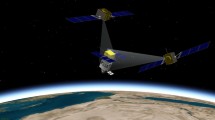Abstract
The problem of navigation for the distributed satellites system using relative range measurements is investigated. Firstly, observability for every participating satellites is analyzed based on the nonlinear Keplerian model containing J2 perturbation and the nonlinear measurements. It is proven that the minimum number of tracking satellites to assure the observability of the distributed satellites system is three. Additionally, the analysis shows that the J2 perturbation and the nonlinearity make little contribution to improve the observability for the navigation. Then, a quasi-consistent extended Kalman filter based navigation algorithm is proposed, which is quasi-consistent and can provide an online evaluation of the navigation precision. The simulation illustrates the feasibility and effectiveness of the proposed navigation algorithm for the distributed satellites system.
Similar content being viewed by others
References
Schetter T, Campbell M, and Surka D, Multiple agent-based autonomy for satellite constellations, Artificial Intelligence, 2003, 145: 147–180.
Norma M and Heinz N I, Agent-based artificial immune system model for the detection of faults in a distributed satellite system, Proceedings of the First AESS European Conference on Satellite Telecommunications (ESTEL), Rome, 2012, 1–6.
Tapley B D, Ries J C, Davis G W, et al., Precision orbit determination for TOPEX/POSEIDON, Journal of Geophysical Research, Dec. 1994, 99(C12): 24383–24404.
Kang W, Ross I M, Pham K, et al., Autonomous observability of networked multisatellite systems, Journal of Gudance, Control, and Dynamics, 2009, 32(3): 869–877.
Markley F L, Autonomous navigation using landmark and intersatellite data, AIAA/AAS Astrodynamics Conference, Seattle, WA, 1984.
Psiaki M L, Autonomous low-Earth-orbit determination from magnetometer and sun sensor data, Journal of Guidance, Control, and Dynamics, 1999, 22(2): 296–302.
Long A C, Leung D, Folta D, et al., Autonomous navigation of high-Earth satellites using celestial objects and Doppler measurements, AIAA/AAS Astrodynamics Specialist Conference, Denver, CO, 2000.
Liu Y and Liu L, Orbit determination using satellite-to-satellite tracking data, Chinese Journal of Astronomy and Astrophysics, 2001, 1(3): 281–286.
Grechkoseev A K, Study of observability of motion of an orbital group of navigation space system using intersatellite range measurements I, Journal of Computer and Systems Sciences International, 2011, 50(2): 293–308.
Grechkoseev A K, Study of observability of motion of an orbital group of navigation space system using intersatellite range measurements II, Journal of Computer and Systems Sciences International, 2011, 50(3): 472–482.
Huxel P J and Bishop R H, Navigation algorithms and observability analysis for formation flying missions, Journal of Guidance, Control and Dynamics, 2009, 32(4): 1218–1231.
Hill K and Born G H, Autonomous interplanetary orbit determination using satellite-to-satellite tracking, Journal of Guidance, Control and Dynamics, 2007, 30(3): 679–686.
Hill K and Born G H, Autonomous orbit determination from lunar halo orbits using crosslink range, Journal of Spacecraft and Rockets, 2008, 45(3): 548–553.
Psiaki M L, Autonomous orbit determination for two spacecraft from relative position measurements, Journal of Guidance, Control, and Dynamics, 1999, 22(2): 305–312.
Yim J R, Crassidis J L, and Junkins J L, Autonomous orbit navigation of two spacecraft system using relative line of sight vector measurements, Proceedings of the AAS Space Flight Mechanics Meeting, Maui, Hawaii, USA, Feb. 2004.
Shorshi G and Bar-Itzhack I Y, Satellite autonomous navigation and orbit determination using magnetometers, Proceedings of the 31st Conference on Decision and Control, Tucson, Arizona, 1992, 542–548.
Wiegand M, Autonomous satellite navigation via Kalman filter of magnetometer data, Acta Astronautica, 1996, 38(4–8): 395–403.
Bar-Shalom Y, Li X R, and Kirubarajan T, Estimation with Application to Tracking and Navigation, John Wiley & Sons Inc., New York, 2001.
Jiang Y G, Xue W C, Huang Y, et al., The consistent extended Kalman filter, Proceedings of the 33rd Chinese Control Conference, Nanjing, China, July, 2014.
Sabol C, Burns R, and McLaughlin C A, Satellite formation flying design and evolution, Journal of Spacecraft and Rockets, 2001, 38(2): 270–278.
Clohessy W and Wiltshire R, Terminal guidance systems for satellite rendezvous, Journal of the Aerospace Sciences, 1960, 27: 653–674.
Roy A E, Orbital Motion, 4th Edition, Institute of Physics Publishing, Bristol, 2005.
Isidori A, Nonlinear Control Systems, 3rd Edition, Springer-Verlag World Publishing Corp, London, 1995.
Eckart C and Young G, A principal axis transformation for non-hermitian matrices, Bulletin of the American Mathematical Society, 1939, 45: 118–121.
Dochain D, Tali-Mammar N, and Babary J P, On modeling, monitoring and control of fixed bed bioreactors, Computers & Chemical Engineering, 1997, 21(11): 1255–1266.
Klema V C and Laub A J, The singular value decomposition: Its computation and some applications, IEEE Transaction Automatic Control, 1980, 25(2): 164–176.
Simon D, Optimal State Estimation — Kalman, H∞, and Nonlinear Approaches, John Wiley & Sons Inc., New Jersey, 2006.
Author information
Authors and Affiliations
Corresponding author
Additional information
This research was supported by the National Basic Research Program of China under Grant No. 2014CB845303 and the National Center for Mathematics and Interdisciplinary Sciences, Chinese Academy of Sciences.
This paper was recommended for publication by Editor HUANG Jie.
Rights and permissions
About this article
Cite this article
Su, Q., Huang, Y. Observability Analysis and Navigation Algorithm for Distributed Satellites System Using Relative Range Measurements. J Syst Sci Complex 31, 1206–1226 (2018). https://doi.org/10.1007/s11424-018-6096-1
Received:
Revised:
Published:
Issue Date:
DOI: https://doi.org/10.1007/s11424-018-6096-1




